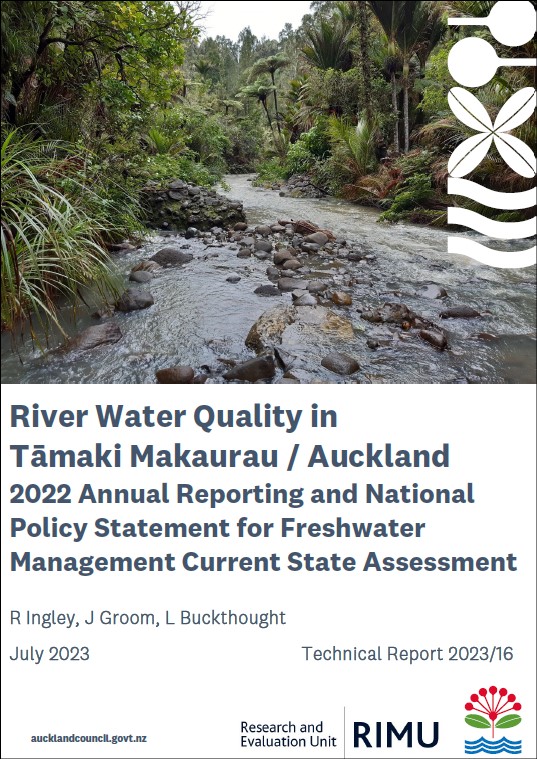River water quality in Tāmaki Makaurau Auckland 2022 annual reporting NPSFM current state assessment
Author:
Rhian Ingley, Jane Groom, Laura BuckthoughtSource:
Auckland Council Research and Evaluation Unit, RIMUPublication date:
2023Topics:
EnvironmentExecutive summary
Freshwater environments, including flowing rivers and streams, wetlands and lakes, are valued by the people of Tāmaki Makaurau / Auckland. RIMU monitors the state of rivers and streams in the region to provide evidence for the integrated environmental management outcomes that Auckland Council is responsible for, as required under section 35 of the Resource Management Act 1991 (as amended). River water quality is monitored monthly at 37 sites across the Auckland region to evaluate nutrient enrichment (toxicity and eutrophication), sedimentation and water clarity, metal contamination, and faecal pollution. These monitored factors are influenced by point and diffuse source discharges, land and instream erosion, as well as natural environmental and climatic variability.
The main forms of analysis of water quality that are presented in this report are:
- Commentary on notable water quality observations within the most recent hydrological year and summary annual statistics for this period (2021 to 2022 only).
- Presentation of range of values observed per site and water quality parameters over the past five years for all parameters and summary statistics for this period (July 201 7 to 30 June 2022).
- Grading against the National Policy Statement for Freshwater Management (NPS-FM) 2020 National Objectives Framework (NOF) bands for current state assessment. This assessment differs from previous current state reports as assessment has shifted to a five-year hydrological year period (from 1 July 2018 to 30 June 2022) rather than a calendar year (January to December) period. Assessment has also been revised to align with the amendments to the NPS-FM 2020 released by the Ministry for the Environment in December 2022.
Water quality has been summarised using the regional water quality index in relation to region-specific guidelines. This assessment was undertaken based on the three-year calendar period of 1 January 2019 to 31 December 2021. The use of the regional water quality index is currently being phased out in preference of the NOF. The NPS-FM 2020 NOF defines a number of compulsory attributes to measure values of freshwater environments. This report specifically focuses on the water quality component of the ecosystem health value, and one measure of the human contact value.
Key messages derived from this national assessment are:
- Regionally there is a low risk of nitrate or ammonia toxicity effects to aquatic fauna even for the most sensitive species. There are localised issues where streams fail nitrate toxicity national bottom lines in the Pukekohe Specified Vegetable Growing Area (nitrate).
- Adverse effects from nutrient enrichment can occur at concentrations far lower than the toxicity thresholds. Pilot monitoring programmes have been initiated or expanded to monitor communities of periphyton (algae) and continuous measures of dissolved oxygen in streams that will provide further information on ecosystem responses to nutrient enrichment in Auckland streams in the future.
- Only two monitored streams failed the national bottom line (band D) for visual clarity. This is a provisional assessment based on converted turbidity records. Direct measurement of visual clarity has been initiated from July 2022 to align assessment of this attribute. The visual clarity attribute is based on median conditions, i.e. how the stream is 50% of the time, and it does not address storm based sedimentation events that can contribute large loads of sediment to streams and coastal environments.
- Draft regional attributes have been proposed for metal (copper and zinc) toxicity. Metal contamination is predominantly an issue in urban waterways however the assessment of the risk of toxic effects on aquatic fauna will change when toxicity modifying factors that influence metal bio-availability, are further incorporated.
- Faecal contamination of rivers, as indicated by Escherichia coli, is a widespread issue across Auckland with all urban and rural streams falling in D or E bands. While this has implications for human contact with rivers and streams, this assessment is not in relation to identified primary contact sites or the summer bathing season.
Auckland Council technical report, TR2023/16
July 2023
See also
Datasheets
2023
To be published soon.
2020
River water quality Auckland datasheet 2020 annual data summary statistics
River water quality Auckland datasheet NOF five year summary statistics 2016-2020
